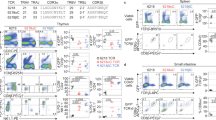Abstract
THE αβ T-cell receptors (TCRs) react with complex ligands composed of peptides bound to major histocompatibility complex (MHC) proteins. In the absence of foreign antigens the peptides bound to MHC molecules come from the proteins of the host itself1–5. Interactions between TCRs and these self-peptide–MHC ligands work positively to drive T-cell development in the thymus6–9 and negatively to delete or inactivate T cells with potential self-reactivity10–12. On the cell surface, MHC proteins are associated with many different self peptides, making it impossible to know which self peptide was involved in positive or negative interactions with a particular T cell. These studies as well as in vitro studies on TCR–peptide–MHC interactions would be aided by a means of producing MHC molecules containing a single peptide. We have tackled this problem for MHC class II proteins by genetically attaching the peptide by a flexible peptide linker to the amino terminus of the class II β-chain. Here we report that a secreted, soluble form of this covalent peptide-MHC complex can be expressed in insect cells. The peptide is engaged by the peptide-binding groove of the secreted MHC molecule and this complex is recognized by T cells bearing receptors specific for that combination.
This is a preview of subscription content, access via your institution
Access options
Subscribe to this journal
Receive 51 print issues and online access
$199.00 per year
only $3.90 per issue
Buy this article
- Purchase on Springer Link
- Instant access to full article PDF
Prices may be subject to local taxes which are calculated during checkout
Similar content being viewed by others
References
Falk, K., Rotzschke, K., Stevanovic, S., Jung, G. & Rammensee, H. G. Nature 351, 290–296 (1991).
Rudensky, A. Y., Preston-Hulburt, P., Hong, S. C., Barlow, A. & Janeway, C. A. Nature 353, 622–627 (1991).
Hunt, D. F. et al. Science 256, 1817–1820 (1992).
Newcomb, J. R. & Cresswell, P. J. Immun. 150, 499–507 (1993).
Marrack, P., Ignatowicz, L., Kappler, J. W., Boymel, J. & Freed, J. H. J. exp. Med. 178, 2173–2183 (1993).
Sprent, J., Lo, D., Gao, E. & Ron, Y. Immun. Rev. 101, 173–190 (1988).
Lee, N., Loh, D. & Lacy, E. J. exp. Med. 175, 1013–1027 (1992).
Robey, E. A. et al. Cell 69, 1089–1096 (1992).
Sherman, L. A., Hesse, S. V., Irwin, M. J., La Face, D. & Peterson, P. Science 258, 815–821 (1992).
Kappler, J. W., Roehm, N. & Marrack, P. Cell 49, 273–280 (1987).
Kisielow, P., Bluthmann, H., Staerz, U. D., Steinmetz, M. & von Boehmer, H. Nature 333, 742–746 (1988).
Murphy, K., Heimberger, A. & Loh, D. Science 250, 1720–1723 (1990).
Brown, J. H. et al. Nature 364, 33–39 (1993).
Bjorkman, P. J. et al. Nature 329, 512–518 (1987).
Fremont, D., Matsumura, M., Stura, E., Peterson, P. & Wilson, I. Science 257, 919–926 (1992).
Stern, L. & Wiley, D. Cell 68, 465–477 (1992).
Hansburg, D., Fairwell, T., Schwartz, R. H. & Appella, E. J. Immun. 131, 319–324, (1983).
Shimonkevitz, R., Colon, S., Kappler, J., Marrack, P. & Grey, H. J. Immun. 133, 2067–2074 (1984).
Sadegh-Nasseri, S. & Germain, R. N. Nature 353, 167–170 (1991).
Sharma, S. D. et al. Proc. natn. Acad. Sci. U.S.A. 88, 11465–11469 (1991).
Mathis, D., Benoist, C., Williams, V., Kanter, M. & McDevitt, H. Cell 32, 745–754 (1983).
Lechler, R., Norcross, M. & Germain, R. J. Immun. 135, 2914–2922 (1985).
White, J., Pullen, A., Choi, K., Marrack, P. & Kappler, J. W. J. exp. Med. 177, 119–125 (1993).
White, J., Haskins, K., Marrack, P. & Kappler, J. J. Immun. 130, 1033–1037 (1983).
Kappler, J. W., Skidmore, B., White, J. & Marrack, P. J. exp. Med. 153, 1198–1214 (1981).
Author information
Authors and Affiliations
Rights and permissions
About this article
Cite this article
Kozono, H., White, J., Clements, J. et al. Production of soluble MHC class II proteins with covalently bound single peptides. Nature 369, 151–154 (1994). https://doi.org/10.1038/369151a0
Received:
Accepted:
Issue Date:
DOI: https://doi.org/10.1038/369151a0
This article is cited by
-
Large libraries of single-chain trimer peptide-MHCs enable antigen-specific CD8+ T cell discovery and analysis
Communications Biology (2023)
-
The interplay between membrane topology and mechanical forces in regulating T cell receptor activity
Communications Biology (2022)
-
LAG-3 inhibits the activation of CD4+ T cells that recognize stable pMHCII through its conformation-dependent recognition of pMHCII
Nature Immunology (2018)
-
A cell-based high-throughput screening assay system for inhibitor compounds of antigen presentation by HLA class II molecule
Scientific Reports (2017)
-
MHC class II complexes sample intermediate states along the peptide exchange pathway
Nature Communications (2016)
Comments
By submitting a comment you agree to abide by our Terms and Community Guidelines. If you find something abusive or that does not comply with our terms or guidelines please flag it as inappropriate.



